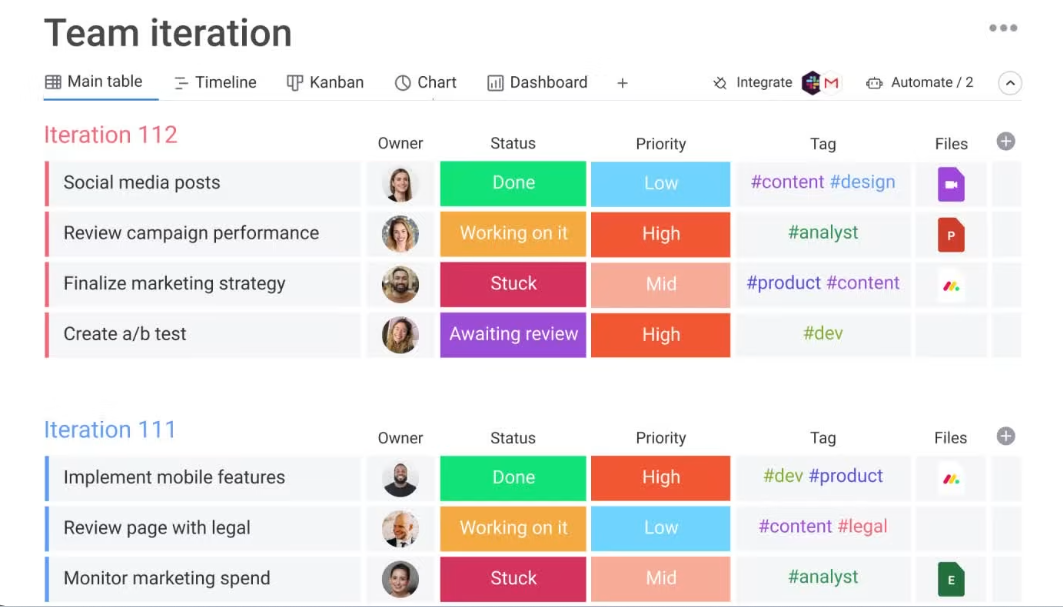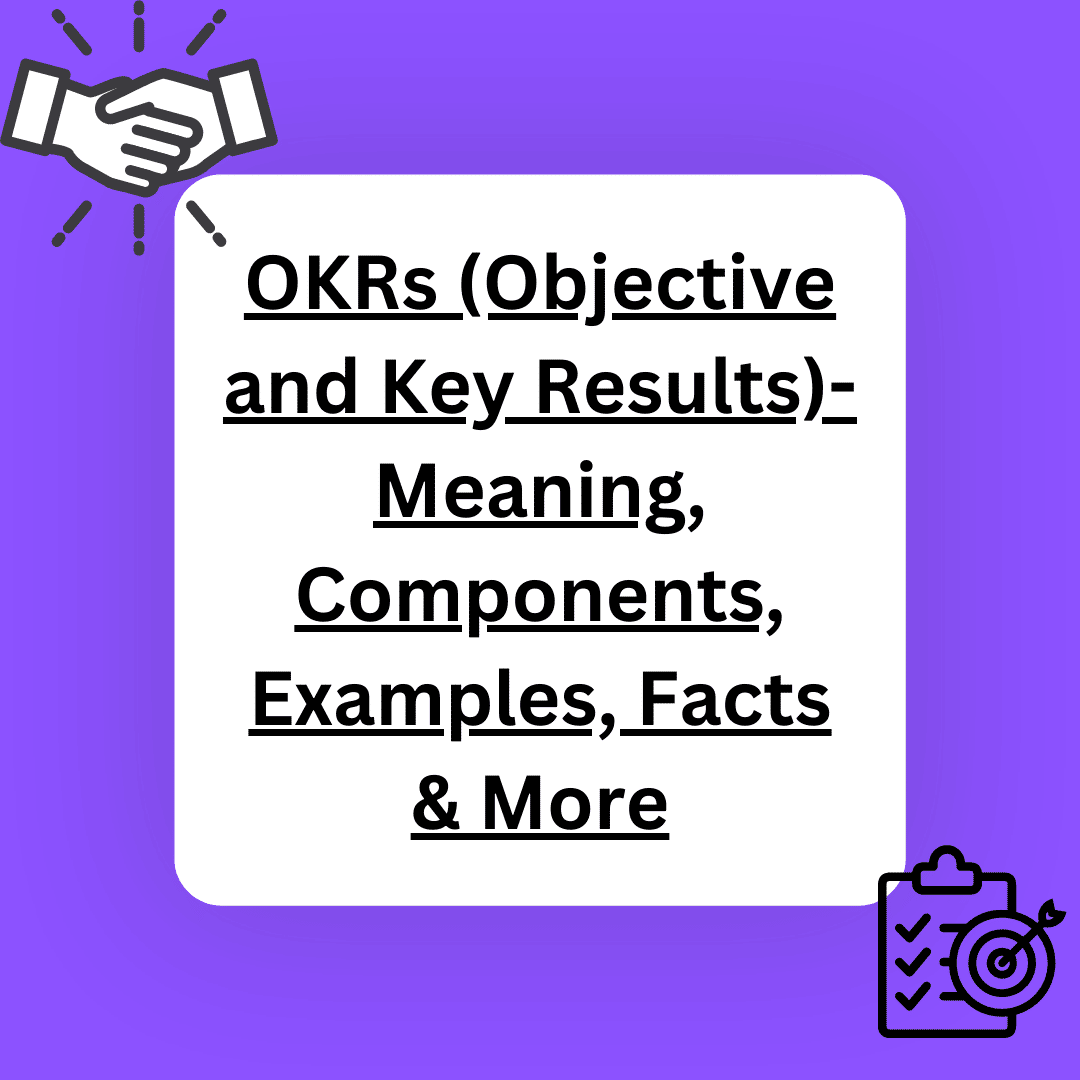Are your projects often derailed by chaos and disorganization? Statistics indicate that 77% of high-performing projects use Project Management Software.
This blog post is your guide to using organizational strategies for keeping your tasks on track, improving efficiency, and achieving results.
Key Takeaways
- Organizational strategy involves creating a plan and aligning projects with company goals to keep tasks on track.
- There are five types of organizational strategies: corporate, functional, operational, simplicity, and universal.
- Using project management software like monday.com can help streamline communication, task coordination, and visualization of project progress.
- To keep your project on track, set clear expectations, utilize organization tools/apps, create individual project plans, implement visual organization methods, maintain effective communication, and regularly review progress.
What Is Organizational Strategy for Project Management?

Organizational strategy for project management involves aligning projects with company goals and creating action plans to direct and accomplish objectives.
Defining organizational strategy
Organizational strategy is a plan made by company leaders. It helps direct all the actions and decisions in a company. This way, the whole team works toward the same goal. The plan sets up what needs to be done, who will do it, and when they should finish it.
This keeps every project on track with time and resources. With an organizational strategy, each action matches the big goals of the business.
Importance for businesses
Businesses find organizational strategy important. It gives them a clear path to reach their goals. This means making plans and using resources well. When businesses use good strategies, they can do more with less.
For example, a business may have a plan for each project. This helps the team know what they need to do and when to do it. This keeps the projects on track and helps meet company goals.
Companies also use tools like charts or apps that make work easy and fast.
How it works
Organizational strategy starts with a plan. This plan spells out the company’s goals, action plans, and decision-making frameworks. Each goal has clear steps attached to it. These steps are tasks that teams must do.
Project managers spread these tasks among team members. They use task coordination tools to make sure everyone knows what they need to do and when. Tools like monday.com help a lot here.
The project manager keeps an eye on time management too so the project stays on track.
They also look at how much of each type of resource they have and need for each task. This is called resource allocation.
The next step is communication – sharing updates with all team members often.
Making sure all this happens right is risk management in work.
Now comes performance evaluation or review time! Here, leaders check how well they stuck to the initial plan and met their goals using metrics and milestones as markers.
This cycle repeats every time there’s a new project or goal for achievement within any business organization big or small!
Types of Organizational Strategy

There are five types of organizational strategy: corporate, functional, operational, simplicity, and universal.
The five types: corporate, functional, operational, simplicity, and universal
Organizational strategies in project management can take different forms, each with its own benefits and applications. Here are the five types of organizational strategies that businesses can utilize to keep their projects on track:
| Strategy Type | Description |
| Corporate Strategy | This type of strategy focuses on the overall direction and goals of the entire organization. It involves making decisions that align with the company’s vision and mission, ensuring that projects contribute to the overarching objectives. |
| Functional Strategy | With this strategy, the focus is on specific functions or departments within the organization. It involves aligning projects with departmental goals and ensuring coordination between different functional areas. |
| Operational Strategy | Operational strategies concentrate on improving operational processes and efficiency. They seek to optimize resource allocation, streamline workflows, and enhance productivity at every level of the organization. |
| Simplicity Strategy | This approach emphasizes simplicity in project management by reducing complexity and unnecessary steps. It aims to eliminate waste, simplify processes, and improve overall efficiency. |
| Universal Strategy | The universal strategy takes a holistic approach to project management by integrating elements from multiple types of organizational strategies. It seeks to align projects with both corporate goals and functional requirements for maximum effectiveness. |
Examples of each type
Organizational strategy in project management is important for businesses to achieve their goals and stay on track. There are different types of organizational strategies that can be used, such as:
| Strategy Type | Description |
|---|---|
| Corporate Strategy | This focuses on the overall direction and goals of the company. Examples include expanding into new markets or acquiring other companies. |
| Functional Strategy | This aligns the activities of specific departments or functions within the organization with the overall corporate strategy. Examples include marketing strategies or HR strategies. |
| Operational Strategy | This involves identifying and implementing ways to improve operational efficiency and effectiveness. Examples include streamlining processes or implementing new technology. |
| Simplicity Strategy | This emphasizes reducing complexity within the organization to improve productivity and customer satisfaction. Examples include simplifying product lines or eliminating unnecessary steps in a process. |
| Universal Strategy | This involves using a combination of different strategies to meet organizational needs. It takes into account all aspects of the business and aims for a comprehensive approach. |
Using monday. com for Organizational Strategy

monday.com offers numerous benefits for creating and implementing an effective organizational strategy, from streamlining communication and task coordination to visualizing project progress in a user-friendly platform.
Benefits of using monday.com
- monday.com is a project management platform that offers many benefits for businesses.
- It helps streamline project management processes and keep projects organized.
- The platform allows for easy collaboration and communication among team members.
- It provides a centralized location for all project – related information and documents.
- monday.com offers customizable features to fit the specific needs of different projects and teams.
- The platform includes visual tools, such as charts and timelines, to help track progress and milestones.
- With monday.com, project managers can easily assign tasks, set deadlines, and monitor team performance.
- The platform also provides analytics and reporting features to evaluate project success and make data-driven decisions.
- monday.com integrates with other popular tools and apps, making it easy to connect different workflows and systems.
- Using monday.com can improve overall productivity and efficiency in project management.
How to create an organizational strategy with monday.com
To create an organizational strategy with monday.com, follow these steps:
- Identify your company goals and objectives that need to be accomplished through the project.
- Determine the specific actions and tasks required to achieve those goals.
- Set clear expectations for each task, including deadlines, responsibilities, and desired outcomes.
- Use monday.com’s organization features, such as boards and timelines, to visually map out the project and its various components.
- Assign tasks to team members using monday.com’s collaborative tools and ensure everyone understands their roles.
- Utilize monday.com’s communication features to foster effective communication and collaboration among team members.
- Regularly review progress and make adjustments as needed using monday.com’s tracking and reporting capabilities.
- Monitor key metrics and milestones throughout the project timeline to evaluate progress towards goals.
- Continuously align the project with the overall organizational strategy by referring back to company objectives.
- Leverage monday.com’s data analytics tools to gain insights into project performance and make data – driven decisions.
Strategies for Keeping Your Project on Track

To keep your project on track, set clear expectations, utilize organizational tools/apps, create individual project plans, implement visual organization methods, maintain effective communication, and regularly review progress.
Set clear expectations
To keep your project on track, it is important to set clear expectations right from the beginning. Clearly define the goals and objectives of the project so that everyone involved understands what needs to be accomplished.
This helps to avoid any confusion or misunderstandings down the line. In addition, clearly communicate the roles and responsibilities of each team member so that everyone knows what is expected of them.
By setting clear expectations, you create a solid foundation for your project and increase the chances of its success.
Utilize organization tools/apps
To stay organized and keep your project on track, it’s important to make use of organization tools and apps. These tools can help streamline project management by keeping all the necessary information in one place.
They allow you to create tasks, assign them to team members, set deadlines, and track progress easily. By utilizing these tools, you can ensure that everyone is on the same page and working towards the same goals.
They also provide a centralized space for communication, where team members can discuss updates, ask questions, and share files. With organization tools/apps at your disposal, you’ll have a more efficient and effective way of managing your project from start to finish.
Create individual project plans
Creating individual project plans is crucial for successfully managing projects and keeping them on track. Here are some key points to consider:
- Identify project objectives and goals: Clearly define what you want to achieve with the project and establish specific, measurable goals.
- Break down tasks and set milestones: Divide the project into smaller tasks and create a timeline with milestones to track progress and ensure timely completion.
- Allocate resources effectively: Determine the necessary resources, such as manpower, budget, and materials, needed for each task in the project plan.
- Assign responsibilities: Assign roles and responsibilities to team members based on their skills and expertise. Clearly communicate expectations to ensure everyone knows their tasks.
- Set deadlines: Establish realistic deadlines for each task in the project plan. This helps keep everyone accountable and ensures efficient progress.
- Anticipate risks and develop contingency plans: Identify potential risks that could derail the project and create contingency plans to mitigate those risks. This way, you can address issues promptly if they arise.
- Regularly monitor progress: Keep track of the project’s progress by regularly monitoring key metrics, such as task completion rates and milestone achievements. This allows you to identify any deviations from the plan early on.
Implement visual organization methods
Visual organization methods are effective tools for keeping projects on track and ensuring clarity in project management. Here are some strategies to implement:
| Strategy | Description |
|---|---|
| Use Charts and Diagrams | Visual representations, such as Gantt charts and flowcharts, can help project managers and teams easily understand project timelines, dependencies, and task progress. |
| Create Visual Timelines | A visual timeline allows everyone involved to see the project’s progression at a glance. It helps with identifying milestones, deadlines, and potential delays. |
| Utilize Color Coding | Assigning different colors to tasks or teams can help visually differentiate between various aspects of the project. This makes it easier to identify priorities and track progress. |
| Adopt Kanban Boards | Kanban boards provide a visual representation of tasks that need to be done, tasks in progress, and completed tasks. They help with task prioritization and workload management. |
| Employ Virtual Whiteboards | Virtual whiteboards allow team members to collaborate in real-time by adding notes, attaching files, or drawing diagrams together. This promotes clear communication and idea sharing. |
| Use Mind Maps | Mind maps are useful for brainstorming ideas, organizing information, and identifying relationships between different project elements. They provide a visual overview of complex concepts. |
Maintain effective communication
Effective communication is crucial for keeping your project on track. When team members are not clear about their roles and responsibilities or if there are misunderstandings, it can lead to delays and mistakes.
Additionally, poor communication can hinder collaboration and slow down decision-making processes. To maintain effective communication, make sure to use clear and simple language when discussing project details.
Regularly update team members on the progress of tasks and milestones using tools like email or chat platforms. Encourage open dialogue and actively listen to feedback from team members.
Regularly review progress
Regularly reviewing progress is a crucial strategy for keeping your project on track. By consistently monitoring metrics and milestones, you can evaluate the success of your project and make necessary adjustments along the way.
This helps you identify any issues or delays early on, allowing you to take corrective action and keep the project moving forward smoothly. Regular reviews also provide an opportunity to assess resource allocation, task prioritization, and overall performance alignment with organizational goals.
By staying proactive in reviewing progress, you ensure that your project stays on schedule and meets its objectives effectively.
Conclusion
In conclusion, organizational strategies are vital for keeping your project on track. By setting clear expectations, utilizing organization tools and apps, creating individual project plans, implementing visual organization methods, maintaining effective communication, and regularly reviewing progress, you can ensure that your project stays organized and aligned with company goals.
With these success strategies in place, you’ll be well-equipped to navigate the challenges of project management and achieve your objectives.
Frequently Asked Questions
What are organizational strategies?
Organizational strategies are plans and methods used to manage and structure tasks, resources, and timelines in order to achieve project goals efficiently.
How can I keep my project on track?
To keep your project on track, it’s important to set clear goals, create a detailed timeline, regularly communicate with team members, monitor progress, and make adjustments as needed.
What is the role of communication in project organization?
Communication plays a crucial role in project organization as it ensures that everyone involved is aware of their responsibilities, updates on progress are shared, and any issues or obstacles are addressed promptly.
How do I prioritize tasks effectively for my project?
To prioritize tasks effectively for your project, start by identifying which tasks are most important for achieving your goals. Consider deadlines, dependencies between tasks, available resources, and potential impact on the overall project outcome when prioritizing.
Are there any tools that can help with organizing and tracking projects?
Yes! There are various tools available such as project management software or online collaboration platforms that can help you organize tasks, allocate resources efficiently,
and track progress throughout your entire project lifecycle



